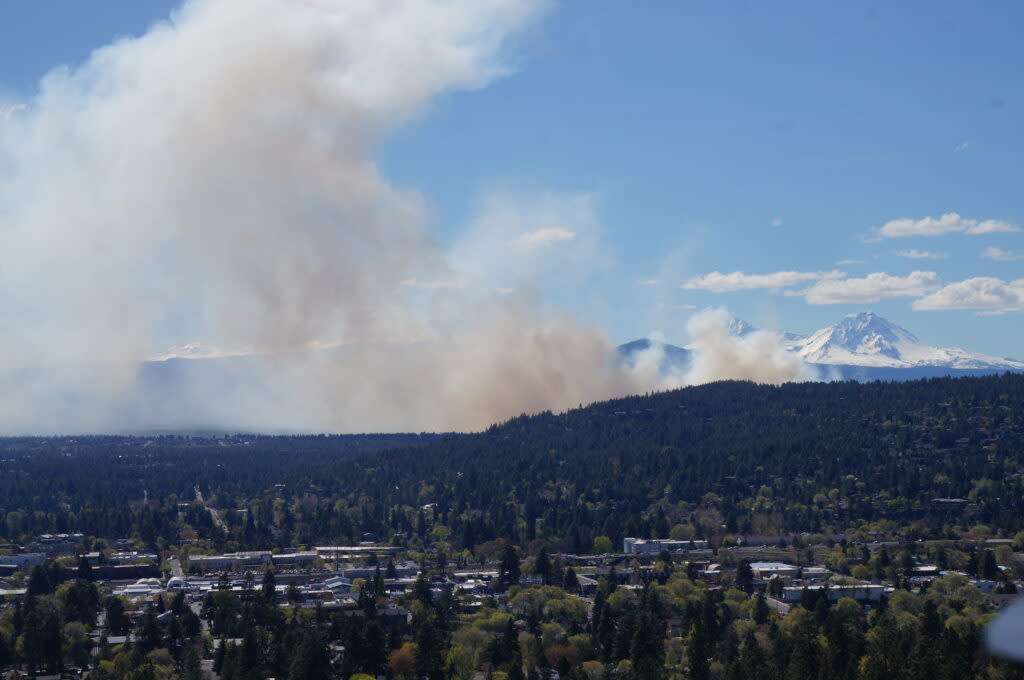State wildfire agencies prepared to respond to fire season but will need more staff in future

Officials manage a controlled burn in Bend on Thursday, May 9, 2024. Oregon wildfire officials said they are increasing the scale of prescribed burns across the state to prevent severe wildfires. (Alex Baumhardt/Oregon Capital Chronicle)
The state’s top wildfire responders say they are prepared for the approaching wildfire season, but they are concerned about adding staff and resources in the future amid expectations that wildfires will increase.
At a news conference Wednesday, the leaders of the Oregon Department of Forestry, the Oregon State Fire Marshal and the Oregon Department of Emergency Management discussed the upcoming wildfire season, which typically begins in mid-May. They predicted a relatively average risk of wildfire through May and June, with a potentially greater risk in eastern Oregon in July and August, when drought and high wind conditions are possible.
Snowpack across Oregon is about average, and it’s been an El Niño winter and spring, which means conditions have been wetter-than-normal. Drought conditions statewide are better than last year but dry conditions persist in some parts of the state, which typically has about 2,000 wildfires a year that burn around 600,000 acres, state data shows.
Chris Cline, interim chief of the fire protection division of the Oregon Department of Forestry, said the agency has the staff and equipment needed for the current year, but that finding and recruiting firefighters has been difficult and will continue to be a challenge in the years ahead.
“The workforce is decreasing and shrinking, and it’s becoming very problematic,” Cline said.
The Oregon Department of Forestry depends on more than 700 permanent and seasonal wildfire fighters, on top of the 11,000 structural firefighters who focus on protecting people, buildings and homes in towns and cities across the state. About 70% of those structural firefighters are volunteers, according to Mariana Ruiz-Temple, Oregon State Fire Marshal, and far more are needed.
“Capacity has gone down over the last 10 years and fires are increasing,” she said. “The Oregon volunteer system is truly the backbone of the Oregon fire service.”
Cline added that incentives from the federal government for wildfire fighters, such as bonuses and higher pay, could draw those firefighters away from state and local agencies. Also, a lack of housing supply and affordable housing in parts of the state make recruitment difficult, Cline said.
Nevertheless, he added, “We have what we need right now, and we will be prepared to protect Oregonians this summer.”
In recent years, state fire agencies have added aircraft and cameras for monitoring fires. They’ve also used state and federal grants to boost seasonal firefighter numbers and to purchase more engines, machines and equipment, while undertaking more preventative prescribed burns.
Cline said agencies are increasing the number of prescribed burns amid a recognition that they are needed to destroy ground brush and other fuel that’s been built up over the years and traditionally was burned off by lightning and tribes conducting low-intensity broadcast burns.
“This is all trying to get (the land) health back to a more natural state,” Cline said.
GET THE MORNING HEADLINES DELIVERED TO YOUR INBOX
The post State wildfire agencies prepared to respond to fire season but will need more staff in future appeared first on Oregon Capital Chronicle.

